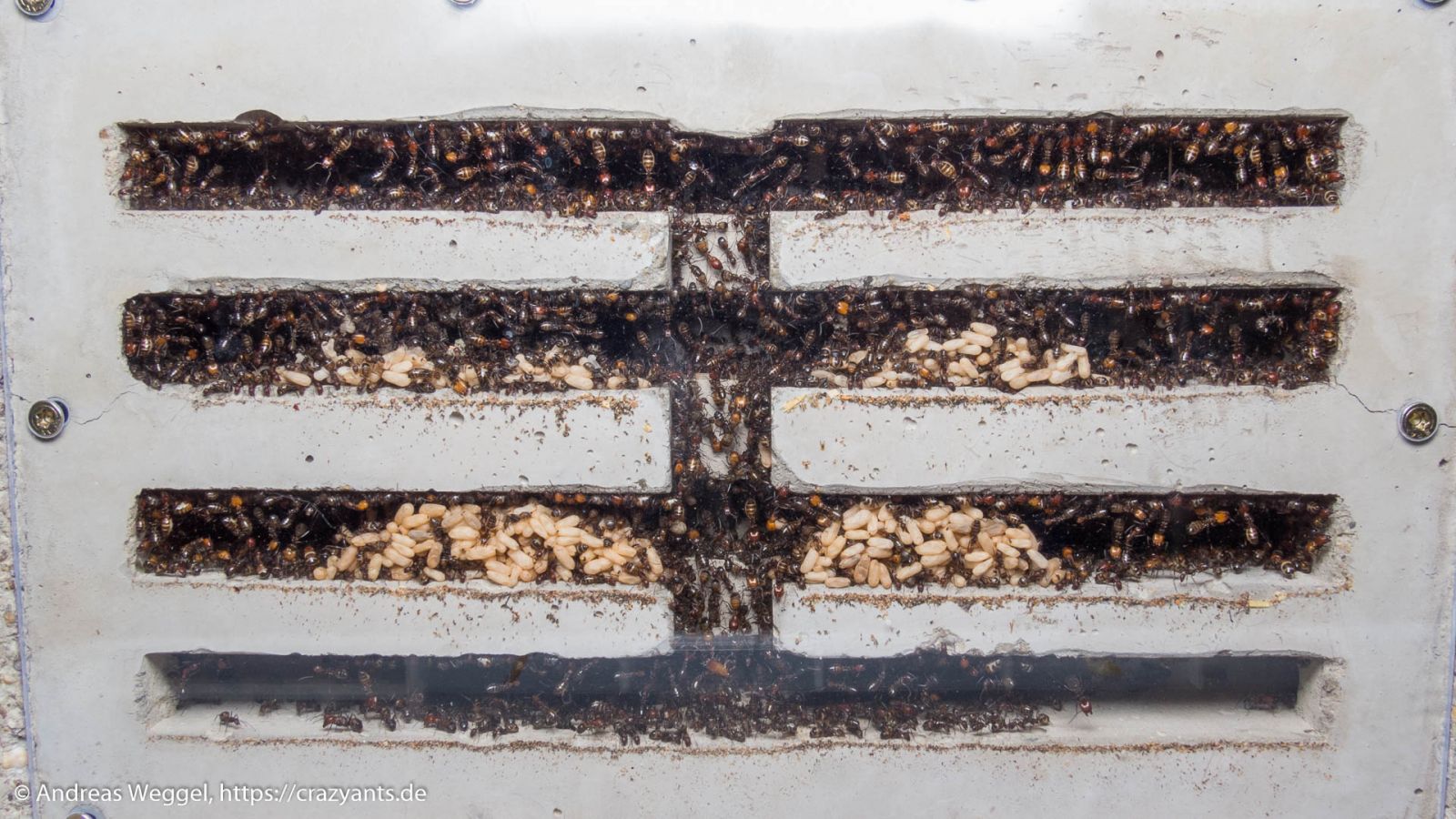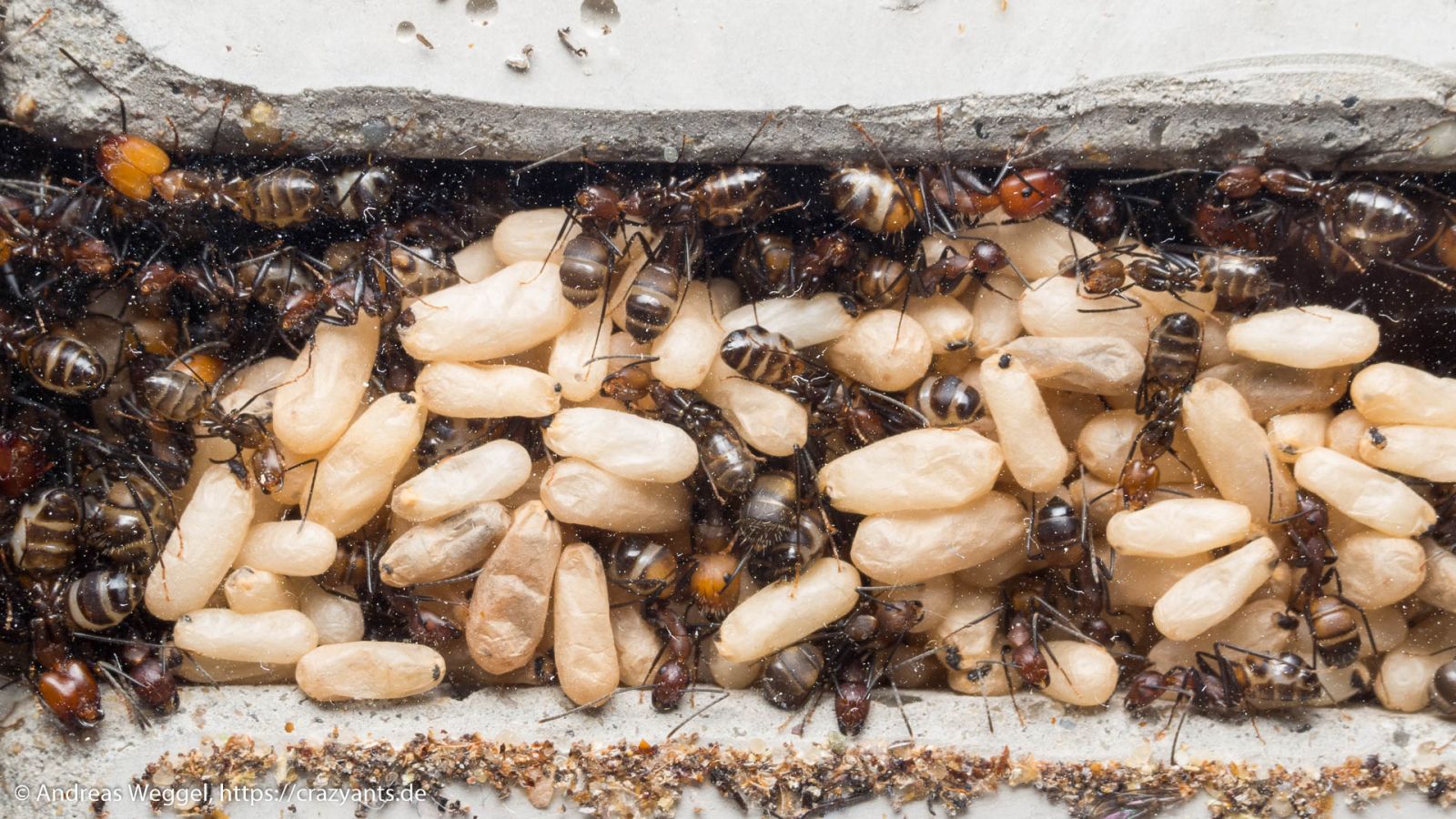Hello,
my Camponotus nicobarensis colony lives in a completely dry nest made out of concrete and does quite well:


Edited by Barristan, November 26 2017 - 9:43 PM.

Hello,
my Camponotus nicobarensis colony lives in a completely dry nest made out of concrete and does quite well:


Edited by Barristan, November 26 2017 - 9:43 PM.
I had a few Camponotous species do well in a dry nest. However I moved them into a wet nest for hibernation. The thing is, I was worried since they where unable to drink from their outworlds, they would dehydrate over winter.
Any thoughts on this?
Yes that could be a problem. I have to admit I have never tried keeping native Camponotus in a dry nest since I had no look so far finding one ![]() . Maybe you could close the nest with some moist material like cotton wool (but that would be quite some work since you have to re moisturize often). Another option would be a nest which can be moisturized so you can only keep them dry during colony's active phase and keep it moist during hibernation.
. Maybe you could close the nest with some moist material like cotton wool (but that would be quite some work since you have to re moisturize often). Another option would be a nest which can be moisturized so you can only keep them dry during colony's active phase and keep it moist during hibernation.
The nest I use also has a small needle through which I could apply water to the inside but I only used this a few times when I first got the nest and wasn't sure the ants would tolerate the dry environment.
Edited by drtrmiller, November 26 2017 - 11:40 PM.
There's studies with Camponotus pennsylvanicus showing that their brood starts to develop deformations at around 20% humidity, anything above is no problem. Considering that 20% humidity is WAAAAAAAAAAAAAAAAY off anything you'll EVER have in a normal room (you'd need a super strong climate control or an airdryer to achieve that unless you're literally living in the desert) they can be kept in a completely dry nest. Also most ants are able to humidify their nest by simply puking water at specific spots inside the nest, that's especially true for Camponotus with their huge social stomachs.
My C. barbaricus live in a fairly dry nest with water tubes attached and they only store their you brood (eggs, tiny larvae) in the water tubes (and sometimes pupae which are near eclosing).
We should respect all forms of consciousness. The body is just a vessel, a mere hull.
Welcome to Lazy Tube - My Camponotus Journal
You describe it as dry, but have you measured the relative humidity both in and outside the nest? I would speculate that two factors are responsible for creating the conditions you're observing:
1) The thickness of the nest material, along with other design considerations, such as a limited number of small entrances, would serve to restrict ventilation, thereby limiting moisture loss.
2) Aerobic respiration in animals involves converting glucose into carbon dioxide and water. The high population density would serve to greatly increase the relative humidity by means of respiration.
The room in which all my colonies are has around 50-55% humidity. I don't have a sensor which would me allow to measure humidity inside the nest. They store parts of insects inside the nest and I've never seen mold so I assume that it is still relatively dry inside.
Think of how a car fogs up on the inside if you sit in it on a cool night with the engine off. That's due to the water vapor in your breath being contained in the poorly ventilated, small space.
Do ants also produce a lot of vapor? I don't know. But I could see that worker ants "lick" the larvae so maybe they keep them moist by this procedure.
Therefore, the ants would likely fare far more poorly if the nest were more highly ventilated, or if there were only a very small number of ants to contribute to the relative humidity inside. Because ants, and larvae especially, are composed of a large percentage of water, claustral queens must found in environments that allow unrestricted access to drinking water at all times. Nests like the one you have described here should be reserved for very large colonies that are capable of occupying most of the space within.
The nest has two 20 mm entrances near ground level and the glass is not glued to the concrete but just screwed to it. I wouldn't recommend such a nest for founding colonies but if there are first workers you could offer the ants such a dry nest and see if they'll move by themselves into it. I never force my ants into a nest (except there is a serious problem with the old one like mold), so I make sure that the new one is good for the ants. When they first moved in the colony size was a lot smaller. That's how the colony looked on May 24th 2017:

There's studies with Camponotus pennsylvanicus showing that their brood starts to develop deformations at around 20% humidity, anything above is no problem. Considering that 20% humidity is WAAAAAAAAAAAAAAAAY off anything you'll EVER have in a normal room (you'd need a super strong climate control or an airdryer to achieve that unless you're literally living in the desert) they can be kept in a completely dry nest. Also most ants are able to humidify their nest by simply puking water at specific spots inside the nest, that's especially true for Camponotus with their huge social stomachs.
My C. barbaricus live in a fairly dry nest with water tubes attached and they only store their you brood (eggs, tiny larvae) in the water tubes (and sometimes pupae which are near eclosing).
I had a few Camponotous species do well in a dry nest. However I moved them into a wet nest for hibernation. The thing is, I was worried since they where unable to drink from their outworlds, they would dehydrate over winter.
Any thoughts on this?
Yes that could be a problem. I have to admit I have never tried keeping native Camponotus in a dry nest since I had no look so far finding one. Maybe you could close the nest with some moist material like cotton wool (but that would be quite some work since you have to re moisturize often). Another option would be a nest which can be moisturized so you can only keep them dry during colony's active phase and keep it moist during hibernation.
The nest I use also has a small needle through which I could apply water to the inside but I only used this a few times when I first got the nest and wasn't sure the ants would tolerate the dry environment.
Edited by T.C., November 27 2017 - 4:55 PM.
Hibernating might be an issue with northern ants that become immobile during hibernation - for my C. barbaricus it is not, they are mediteranian ants that don't really hibernate, they are just very inactive.
We should respect all forms of consciousness. The body is just a vessel, a mere hull.
Welcome to Lazy Tube - My Camponotus Journal
Since the nest is dry you can feed them even raw meat without thought. In the following video they're eating a piece of raw goose breast:
The video was surprising. I expected them to lick the juices off it, but not to carve it up and transport bite-sized chunks to the nest.
In the nest they further chop it down and put the smaller pieces on larvae so they can eat them up.
I can't tell you, since I got it from another ant keeper who quit the hobby. But when I received the colony last year it already had more than 100 workers.
Camponotus nicobarensis a small Camponotus species that grows VERY fast and does not hibernate. They're sometimes referred to as the Formica of the Camponotus genus because they really behave much more like Formica ants than a Camponotus species.
If kept well they can probably grow to a hundred workers in less than 6 months (especially if you consider that my Camponotus barbaricus colony grew to 500+ workers within about 18 months), in fact I've seen journals of Camponotus nicobarensis colonies that managed to grow to multiple thousands within 2 years.
We should respect all forms of consciousness. The body is just a vessel, a mere hull.
Welcome to Lazy Tube - My Camponotus Journal
Camponotus nicobarensis a small Camponotus species that grows VERY fast and does not hibernate. They're sometimes referred to as the Formica of the Camponotus genus because they really behave much more like Formica ants than a Camponotus species.
If kept well they can probably grow to a hundred workers in less than 6 months (especially if you consider that my Camponotus barbaricus colony grew to 500+ workers within about 18 months), in fact I've seen journals of Camponotus nicobarensis colonies that managed to grow to multiple thousands within 2 years.
0 members, 1 guests, 0 anonymous users